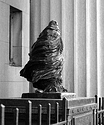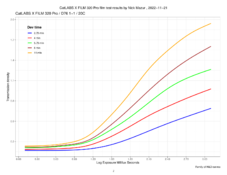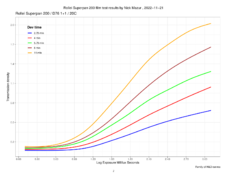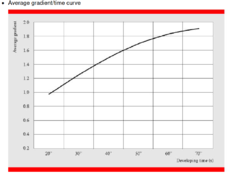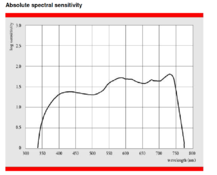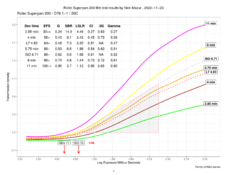I have a couple of plots to share.
This is a comparison of the estimated ISO curves of the CatLABS X FILM 320 Pro (blue) and the Rollei Superpan 200 (red). These ISO curves are curves that comply with the ISO film speed standard, i.e., they have the Average Gradient,
Ḡ, of around 0.62. This plot is meant to show the relative difference in film speed between the two films. The Rollei Superpan 200 is a bit faster in this test (by less than 1/4 of a stop).

And this is a plot of curves that represent the means of the five curves for each film (aggregate means), Rollei Superpan 200 (red) and CatLABS X FILM 320 Pro (blue). This plot is meant to roughly compare the "character" or "look" of these two films. One could characterize the films as having long toes, with limited tonal separation in the shadows, "punchy" mid-tones, and some compression in the highlights. I think this is very consistent with the photographs we've been seeing on this thread, including those by @Huss,
@Pioneer ,
@Oldwino , to name just a few of the recent ones. I am sorry if I left anyone out.

So how do those two curves help us determine whether the two films are similar? Well, statistically, there is not sufficient evidence to determine that the two films are different, but, please, keep in mind, that we are dealing with a very small sample size, so this statement needs to be taken with a grain of salt. However, So far, it is clear that both films share a lot of their DNA:
- they have very similar film speed, though, in my tests, the Rollei is a bit faster, both films being fresh in date
- they respond to development in Kodak D-76 very similarly
- they have very similar B+F density
- they have very similar overall character, look, and feel
- they are coated on very similar polyester base, though Rollei curls more (it's been suggested that maybe it's because it's been rolled up in canister for much longer)
- they release a very similar-looking dye during processing (I only tested the 35mm variant)
- they dry very quickly and resist water drying spots, compared to conventional films by Kodak, Ilford, and Foma
- they are priced very similarly (at Freestyle, Rollei Superpan 200 is currently priced at $7.99, and the CatLABS X FILM 320 Pro at $6.99)
- they are packaged very similarly, though, the CatLABS film canister has electrical tape blocking the DX code
- each film has its own branding on along the edge of the film
There's more analysis coming, so stay tuned.




